Familiarity with bird behaviors gives photographers a much better chance of capturing the shot we’re after.
- Note: This post is not about “pretty pictures”, far from it. Instead it’s about recognizing behaviors of our subjects that allow us to anticipate behaviors that follow, giving us a better chance at capturing that interesting or dramatic shot we’re after. Birds are fast and usually unpredictable so if we can anticipate what comes next our chances of success improve dramatically
First let’s become familiar with a common behavior of American Avocets during their breeding season.
One of the common agonistic (combative, aggressive) behaviors of American Avocets this time of year is called the “Circling Display.” Just before or during nesting two pairs of avocets (or one pair and a single unpaired individual) form a rough circle with their heads facing inward and angled downward. The birds make loud trumpeting sounds as the circle rotates in either direction. Often at some point during the circling display the cluster of avocets will erupt into combat involving two or more birds. Typically the fight is over in a flash and the action is remarkably fast and difficult for the photographer to capture well.
But if you know it’s coming your chances of success improve dramatically.
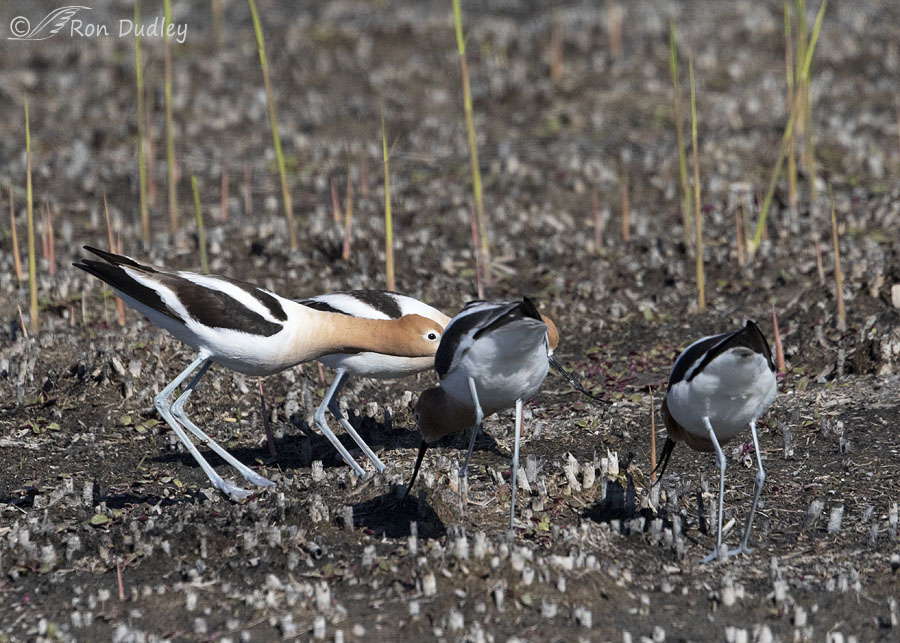
1/6400, f/7.1, ISO 800, Canon 7D Mark II, Canon EF 500mm f/4L IS II USM + EF 1.4 III Extender, not baited, set up or called in
Six days ago I spent some time with a group of American Avocets at Bear River MBR. The setting is unattractive because they were in an area the refuge had burned last year in an effort to control phragmites. It was obvious that many of the avocets had already formed pair bonds but it appeared that some of them were unpaired.
Suddenly four of them began calling loudly as they formed a rough circle and pointed their heads downward. Because I’d seen (and heard) this behavior so many times before I immediately knew it was the Circling Display. I actually said out loud to Mia – “They’re gonna fly at each other and fight.” I quickly checked to make sure I had plenty of shutter speed for the blindingly fast action that would likely follow and waited for one or more of the birds to erupt. What I’ve presented below is a series of six shots in a burst with no skips – the entire episode lasted only .6 sec.
I didn’t have to wait long. It was the bird on the far left that was about to go ballistic (based on size, females are smaller, I believe it was a male).
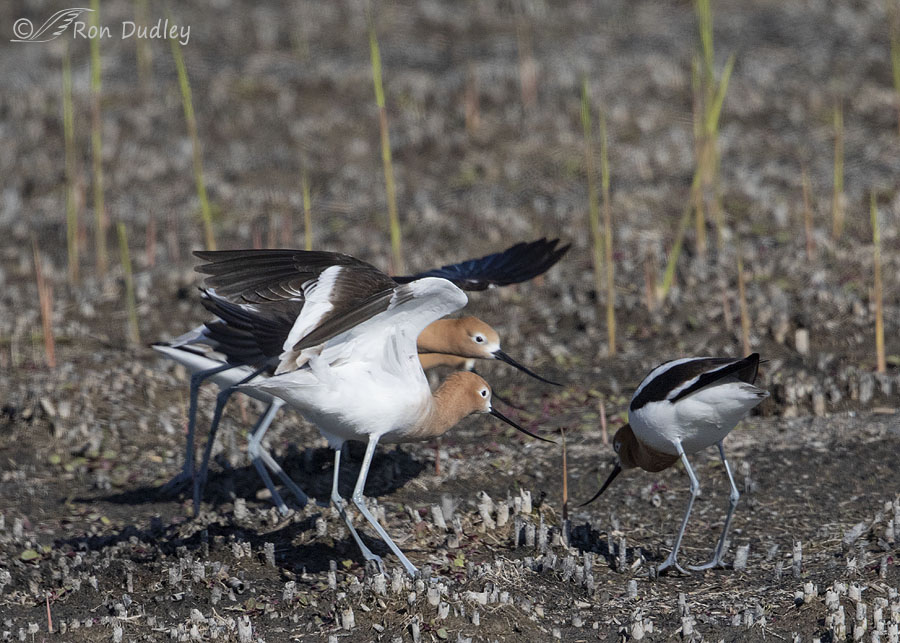
1/6400, f/7.1, ISO 800, Canon 7D Mark II, Canon EF 500mm f/4L IS II USM + EF 1.4 III Extender, not baited, set up or called in
Here he’s beginning to raise his wings in an attack on the bird on the right. The soon-to-be victim knew what was coming and…
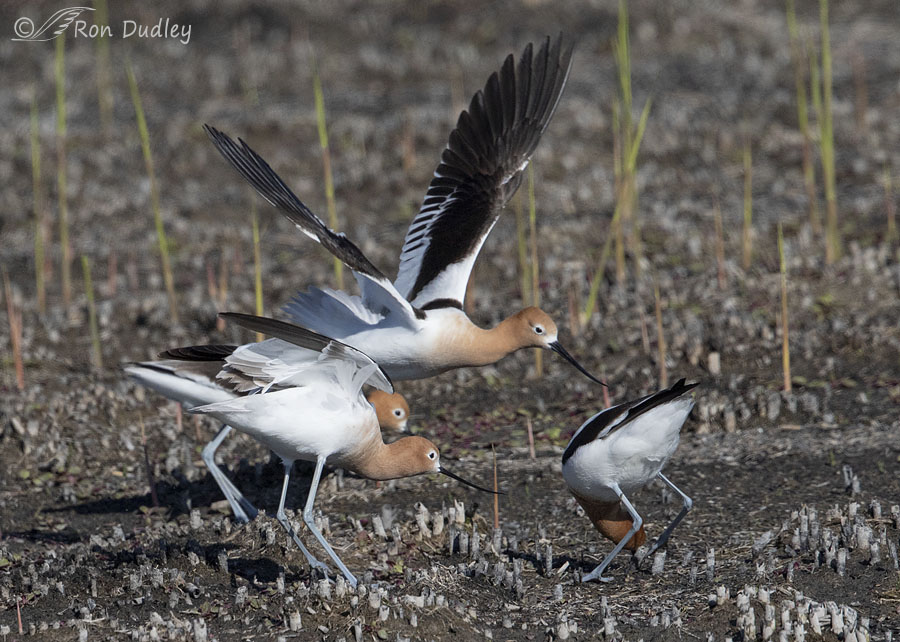
1/6400, f/7.1, ISO 800, Canon 7D Mark II, Canon EF 500mm f/4L IS II USM + EF 1.4 III Extender, not baited, set up or called in
tucked its head down and away in a defensive maneuver.
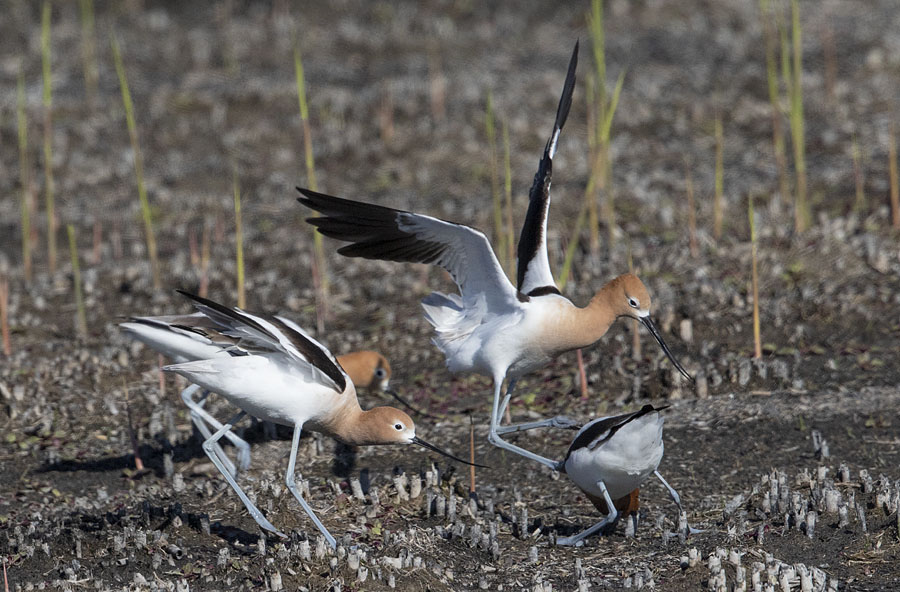
1/8000, f/7.1, ISO 800, Canon 7D Mark II, Canon EF 500mm f/4L IS II USM + EF 1.4 III Extender, not baited, set up or called in
When avocets fight their primary weapon is their feet rather than their bills or wings as demonstrated in the next shot in the burst. The aggressor struck the victim with both feet so it’s a good thing that bird had protected its head.
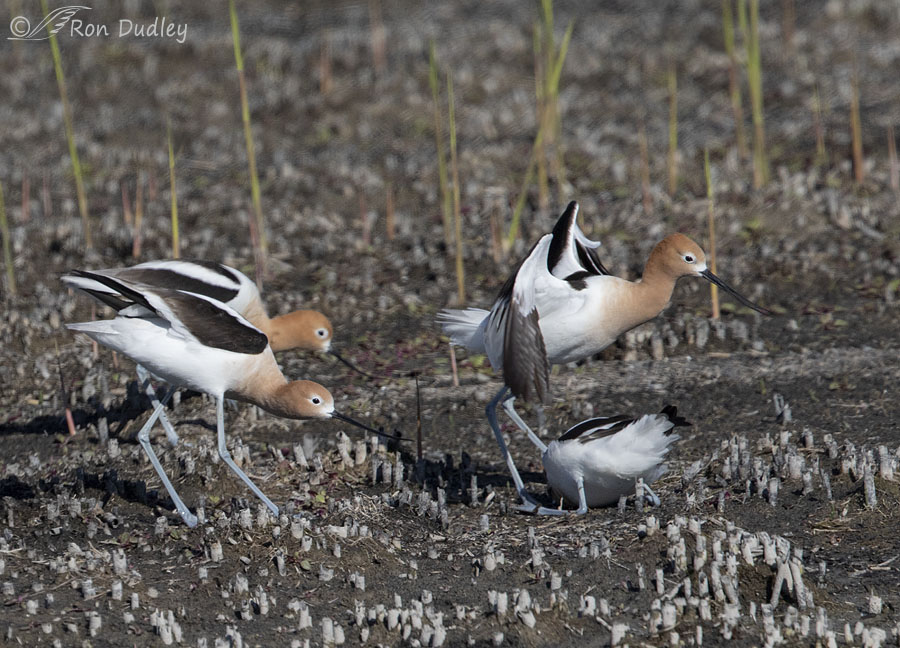
1/5000, f/7.1, ISO 800, Canon 7D Mark II, Canon EF 500mm f/4L IS II USM + EF 1.4 III Extender, not baited, set up or called in
The force of the blow flattened the victim to the ground.
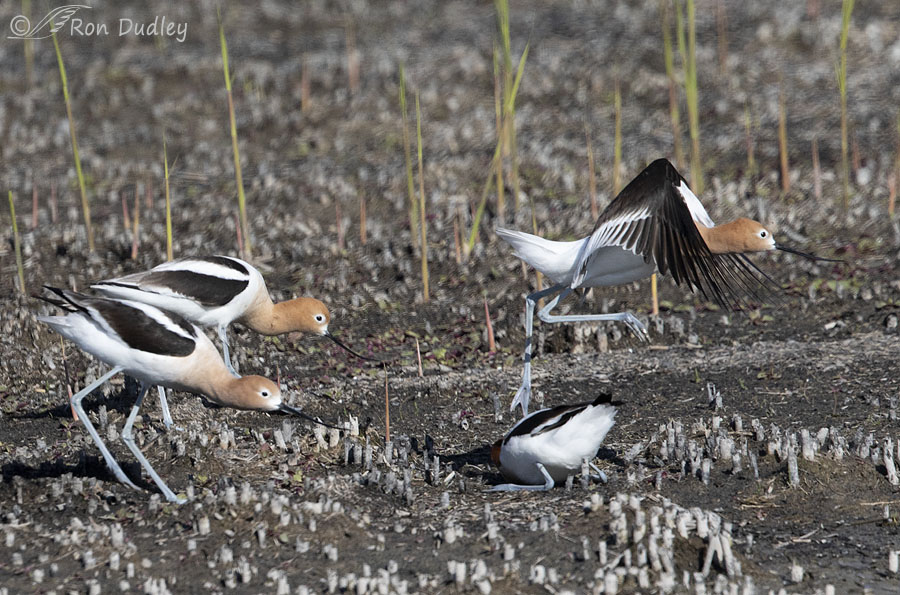
1/5000, f/7.1, ISO 800, Canon 7D Mark II, Canon EF 500mm f/4L IS II USM + EF 1.4 III Extender, not baited, set up or called in
Then the aggressor quickly made his getaway…
1/5000, f/7.1, ISO 800, Canon 7D Mark II, Canon EF 500mm f/4L IS II USM + EF 1.4 III Extender, not baited, set up or called in
with a high-stepping run. The attack was over as quickly as it began. Neither bird flew off and they all resumed their very loud chattering before they settled down to more sedentary behaviors.
In this series I didn’t get any photos I think are great but I was successful in capturing the action and there’s significant satisfaction in that. The experience also gave me more practice for the next time.
Hopefully when it happens it won’t be in such an unattractive setting.
Ron


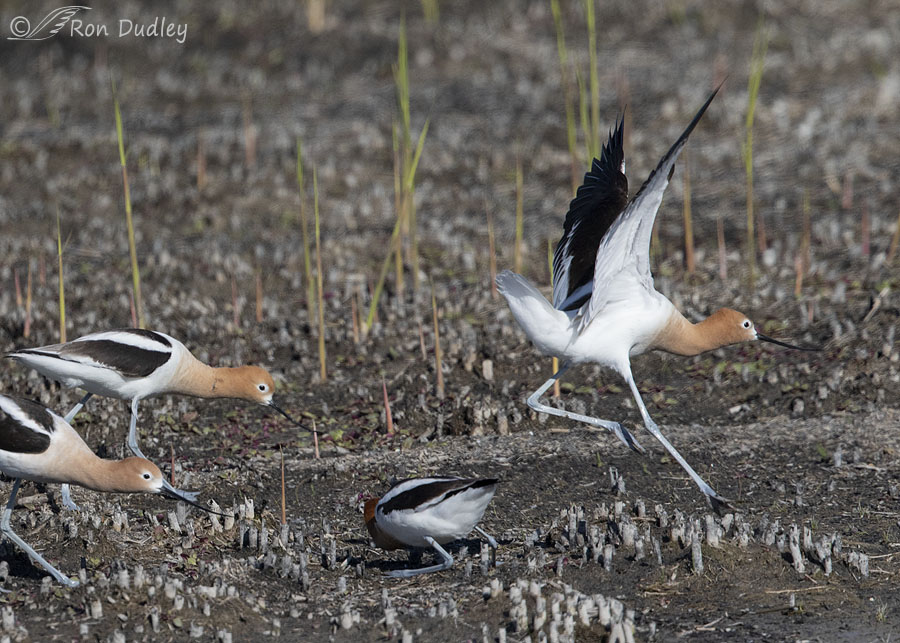
Amazing behavioral series Ron, thanks for sharint!
Charlotte
It was interesting, to say the least. Good for you! Never witnessed this before, so I am glad you captured it. Looks like the chief aggressor is skulking away after the kick.
Thank you, Jane.
Ouch.
So glad that the downed avocet lived to circle another day, but that must have hurt.
Yet another fascinating series.
Megathanks.
That bird was lucky, EC. I once documented an avocet fight where the aggressor went for the eye of the other bird with that needle sharp bill.
Double ouch. With a side order of wince and cringe.
Very rare bird here in Whatcom County, WA. Only about six in 50 years. But I’ll keep an eye out.
Good luck.
Ron,
Wow, another great post. Thanks for the pictures and description of the behavior.
“I didn’t get any photos I think are great but…” To that I would say, “Nonsense!”
Best,
Stephen
Thanks, Stephen. Actually I do think these photos are pretty good for documenting behavior.
Fabulous shots! The background may not be aesthetically pleasing in the traditional sense, but it provides the perfect backdrop for the drama of the fracas.
My music mentor had a saying, “Be at the right place, at the right time, with the right equipment, and the right attitude.” You’ve hit the ball out of the park on that one!
“Be at the right place, at the right time, with the right equipment, and the right attitude”
And if you accomplish all that, some people still call it luck. Go figure… Thanks, Marty.
I call it skill!
Happy “Birthday Eve!”
Thanks, Ron. I didn’t know this about avocets. Excellent description of what’s going on, and nice, sharp photos, even if not works of art this time.
Ha, they’re far from works of art but I’m still happy to have them. Thanks, Nancy.
This is terrific! The speed that incidences like this occur and their lasting time always amazes me. So glad you were ready to document it. You are so right about knowing bird behavior and having info about them ahead of time…I try to read up on the seasonal birds that pass through ahead of time. It always helps to get ‘that shot’ if you know behavior as you said. I’m curious…what did the bird that was stomped on do afterwards. That last photo poses many questions…I like the way the remaining two are looking at the victim…also the ‘bully’ looks like ‘yikes, I’m otta here!’ Great series!!!
Great series!!!
Kathy, immediately, and I do mean immediately, after the fracas was over all four of the avocets resumed their normal activities as if nothing had happened. None of the birds flew off
That is amazing…far different than what I would have thought. You never know about rituals I guess.
Fascinating!! Thank you for telling the story.
Thanks, Arwen.
Fantastic behavioral shots, Ron! I only see Avocets in migration so I’ve never seen this display. And to think that I used to think of them as elegant, regal birds!
They’re a bit chameleon-esque, Diane. They can go from elegant and regal to aggressive playground fighters in an instant.
WOW! Impressive series! Much more interesting than just a portrait to have “the story”!
Much more interesting than just a portrait to have “the story”!  Other than getting out of the way the other 2 appear to be frozen in place….. Amazing no major damage resulted from getting “stomped” like that! Certainly would have to be “ready for it” to capture the action. Great job, Ron……..
Other than getting out of the way the other 2 appear to be frozen in place….. Amazing no major damage resulted from getting “stomped” like that! Certainly would have to be “ready for it” to capture the action. Great job, Ron…….. 
“Other than getting out of the way the other 2 appear to be frozen in place”
Judy, I’m constantly amazed at how fast birds react, or know they don’t have to react, to situations like this. The “victim” in this series, and both birds that didn’t react at all, were all examples of that.
Very interesting and educational post, Ron! Thank you. I will have to look for this the next time I am around avocets (we do not get in the “wetlands” where I live, however, I do get to see them on some of the refuges.
Thank you, Ed. You may not get the wetlands in your area but you get that magical New Mexico light that’s to die for…
That is amazing Ron. What strange behavior. Fortunately you knew of it and were prepared to follow the action. Kind of like grade school in my time when a group of bullies would single out some poor kid at recess and bully him. I don’t think they do that anymore. Very educational series – thanks for sharing.
Everett Sanborn Prescott AZ
Everett, some years ago avocets nested very close to the road at Farmington and I watched the behavior up close many times. Eventually I figured out what was going on in the predictable sequence of behaviors and that was very satisfying for this photographer with a huge interest in behaviors.
Regarding bullying, I think there have always been bullies and there always will be, sadly…
Excellent behavior shots. As much as I like the individual and close-up shots, I love it when you also show a story of behavior in the view finder. Wonderful, thanks for sharing!
Thanks very much, Dick.